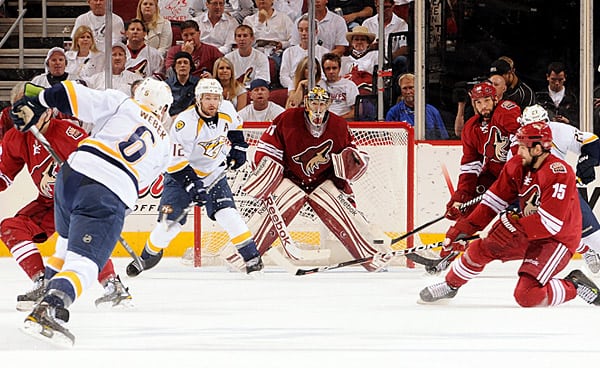
The myth of the blocked shot problem
 The myth of the blocked shot problem
The myth of the blocked shot problemWe all know the story of Bobby Baun. His Game 6 overtime marker sent the 1964 Stanley Cup final to Game 7. He scored it on a broken foot sustained blocking a Gordie Howe slapper. This is just one of hockey’s great moments that never would have happened if the non-stop meddlers of today had their way through history.
Ah, the shot-blocking debate. If it’s not shot-blocking it’s 10 other things.
The Henny Pennies out there are trying to scare us with the return of the Dead Puck Era because the New York Rangers have made a system out of blocking shots. There have been many mentions that this system further indicates the NHL is taking the game out of the skilled players’ hands and putting it back into the hands of the plugs.
What makes no sense here is that, most of the time, the blocked shot happens after a puck is directed at the net from the point. That’s not what you would call a skilled play. In fact, when you take a shot from the point, you’re just hoping someone tips it in, deflects off a defender’s leg or that your guy in front is able to screen the goalie. Tomas Holmstrom, who you wouldn’t lump in with the “skilled players,” made a celebrated career out of this. The perceived prevalence of shot-blocking has nothing to do with the amount of open-ice rushes we get.
If shot-blocking is the new bane of the league, you’d assume the four teams left would be high-ranking officers in this new regime. But that’s not so. We have a wide range and the No. 1 shot blocking team, Washington, isn’t even alive. Last year’s final four in post-season blocked shots per game: The Sharks were fourth, Lightning fifth and the two finalists ranked 13th and 14th.
Nothing about this year’s shot-blocking is new and there hasn’t been an overwhelming number of them that have taken the playoffs hostage either. There have been an average of 15.7 blocked shots per game in these playoffs. Last year it was 16.6. The year before it was 16. This is actually the lowest shot-blocking total we’ve had in three years. And the Rangers, the whole reason this is even being talked about, are blocking fewer shots than a year ago.
It’s the low-hanging fruit. One team has been successful at it, so the meddlers zoom in focus and put the blinders on. Yes, the Rangers are good at it, but the Devils are ranked 15th, the Kings ninth and though the Coyotes are fourth, they still allow the most shots against and play a wicked back-and-forth game. They actually got burned from pinching defense quite a bit in Game 1 of the West final. Want to know a bigger reason goals are down slightly? The teams left can’t convert a power play to save their lives. You can fairly blame blocked shots as a partial reason why, but none of them were any good at it in the regular season. Aside from 14th-ranked New Jersey, the rest of the final four were in the bottom half of the league in PP percentage. Last year, the No. 1, No. 2, No. 6 and No. 20 regular season power plays were left in the playoffs at this point.
If you can’t get through a goal on the man advantage, then use your skill to score at even strength where the rushes happen. (2011 and '12 playoff stats below.)
It seems, for the most part, the teams who score 5-on-5 (when real skill is on display) enjoy success. And the teams who were knocked out early, but rank highly, either played a few overtimes or lost in seven games. When things are that close, there’s very little difference between winning and losing. But the teams who were awful 5-on-5, regardless of PP success, got knocked out easily.
And here we are with the meddlers talking about vast rule changes (a basketball-style key, a rule on leaving your feet to block shots) all because one team left seems to do a good job of blocking shots. Never mind eight of the top 11 teams in blocked shots in the regular season didn’t make the post-season and three of the four teams left standing ranked in the bottom third. This is the definition of a knee-jerk reaction.
But each time, logic prevails. This column isn’t suggesting nothing ever needs to be changed in hockey, but we shouldn’t constantly clamor for change because it’s the popular thing to do on Twitter. The bottom line is you have to be successful 5-on-5 to win the Stanley Cup – and isn’t that how it should be? Isn’t that more skillful than passing it around on a power play designed around the chance point shot? And if the other team blocks an even strength point shot, use your skill to get it down low.
Will a shot-blocking trend balloon if New York wins? Given that no strategy to win has lasted more than two years since the lockout, I wouldn’t bet on it. Not to mention the fact there are a wide range of styles still left in the final four (three of the final four rank in the top five in offense) that have been working just fine. There isn’t one formula for winning. Parity has ensured us of that.
Next time you hear someone toss out rule change demands willy-nilly, please take a step back and look at the big picture.
Rory Boylen is TheHockeyNews.com's web editor. His column appears regularly only on THN.com.
For more great profiles, news and views from the world of hockey, subscribe to The Hockey News magazine.